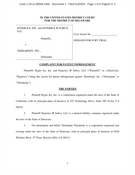-
Intellectual Ventures II LLC v. BITCO General Insurance Corporation f/k/a Bituminous Casualty Corporation et al DC
- 6:18-cv-00298
- E.D. Tex.
- Judge: Rodney Gilstrap
- Filed: 06/21/2018
- Closed: 07/23/2020
- Latest Docket Entry: 07/24/2020
- PACER
- Docket updated daily
1
Plaintiff
1
Defendant
6
Accused
Products
2
Patents-in-Suit
2,012
Days in
Litigation
-
Intellectual Ventures II LLC v. BITCO General Insurance Corporation f/k/a Bituminous Casualty Corporation et al DC
- 6:18-cv-00298
- E.D. Tex.
- Judge: Rodney Gilstrap
- Filed: 06/21/2018
- Closed: 07/23/2020
- Latest Docket Entry: 07/24/2020
- PACER
- Docket updated daily
Cause of Action
Infringement
Market Sector
E-commerce and Software
Assigned Judge
- Patent Information
